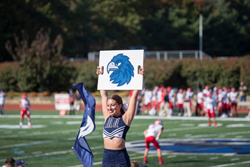The presidential candidates have recently been targeting millennials as a part of their campaigns strategies in order to gain their support in the upcoming election. Candidates have been doing this in a variety of ways, each with different intentions depending on their political party.
The reasons behind candidates’ increased interest in millennials varies but some attribute it to their increased interest in politics. “I think that presidential candidates are targeting millennials because we are becoming increasingly involved in the political process thanks to social media,” said Daniel Roman, a senior political science major and co-captain of the debate team. “This vote is very important because as we can see, younger voters are beginning to make up a larger share of the electorate than what used to be the case.”
Social media has undoubtedly become a major asset to presidential campaigns. Candidates have been utilizing Twitter, Instagram, and other social media platforms to ignite their campaigns. “We are now seeing every candidate take advantage of the use of social media; it would almost be political suicide not to as the candidate would appear to be ‘behind the times,’” said Dr. Stephen Chapman, an assistant professor of political science and sociology.
However, some candidates may overestimate the strength of social media platforms. “I don’t think it works as well with millennials as they think it does. Our social media networks are not created equal. We opt in to who we follow,” said Dr. Michael Phillips-Anderson, an associate professor of communication. “People who are opting in to follow these candidates are already politically engaged.”
“The use of social media is crucial for the campaigns, it could also very easily backfire, a wrong message or poorly worded tweet can hurt candidates,” added Roman.
Social media can be helpful to a campaign as long as it is utilized fittingly. This will depend on their consistent, appropriate, and effective messages. “Each candidate’s team of social media and campaign staff has to keep these components in mind in order to evaluate each campaign accurately; measurement is imperative to evaluating what is working and what is not,” said Mary Harris, Specialist Professor of Communication.
Some candidates have been attempting to reach young adults through different medians. “You want to get at people where they can accidentally find you. You should show up in places where they already are,” said Phillips-Anderson. These places include late night television shows, podcast, and radio broadcasts.
The messages candidates are offering are also crucial to their campaign. “They need to give them messages to come out and vote but also messages that say to them that there really is a benefit to their vote,” said Patrick Murray, Director of the Polling Institute at the University.
Historically, younger voters have followed the patterns of older voters and therefore did not have a large impact on the elections. However, this pattern changed in 2004, “…when younger voters started to appear more democratic than older voters. By 2008 they were significantly more democratic. That trend has continued,” said Murray.
Millennials consist of a large potential voter population, making them appealing to candidates. However young adult voters have had the lowest voter turnout of all age groups. “For example, 2008 had one of the highest turnout rates for younger voters (about 48 percent for 18-24 year olds). This was still the lowest turnout relative to older age groups,” said Chapman. “In 2012, this age group dropped back to a dismal 38 percent voter turnout,” Chapman added.
Many young adults are also new to politics, making them more easily persuaded. “…younger voters may, as a whole, have less crystallized political opinions…making them more susceptible to persuasion by the candidates,” explained Chapman.
It is important to consider the fact that some young adults have already established their political beliefs, making them a little less prone to persuasion. “Those younger voters who have firm beliefs (and many do) will behave just like any other voter,” Chapman continued.
Currently, several millennials have been regarded as mostly democratic. “The proportion of millennials that are democratic is now very close to 2/3 of them…I have a feeling that as we look at closer and closer elections that we are going to see a fight, where we are going to see more democrats trying to get millennials out and republicans trying to keep them at home,” explained Murray.
There is some debate regarding the candidate most likely to win over the Millennial population as a whole. “Rand Paul is a libertarian, and many younger people tend to like the message of individual freedoms, less government intrusion, etc,” said Chapman.
Hillary Clinton is also regarded as a top runner for many young adults. “I think that Hillary is very well positioned to win millennials. President Obama won 67 percent of the youth vote in 2012, and if Hillary can match that she will be in good shape,” explained Roman.
Issues that interest Millennials and are crucial for candidates to address during their campaigns include, “…current and future access to clean drinking water, sustainability and clean energy, food justice and sustainable food systems, national security and cyber security, climate change, and equal rights,” said Harris.
Other issues include gun control, marriage equality, the job market, and student debt. “The most important issue in my opinion to millennials is college debt. It is very rare for a student to graduate without having some form of debt. I think younger voters want to know what candidates plan to do about interest rates,” said Roman.
Essentially, campaigns revolve around approach. “Campaigns really are about strategy, how do I win? How do I spend my resources to win? And that sometimes means ignoring different voter groups,” Murray explained.
IMAGE TAKEN from redalertpolitics.com




